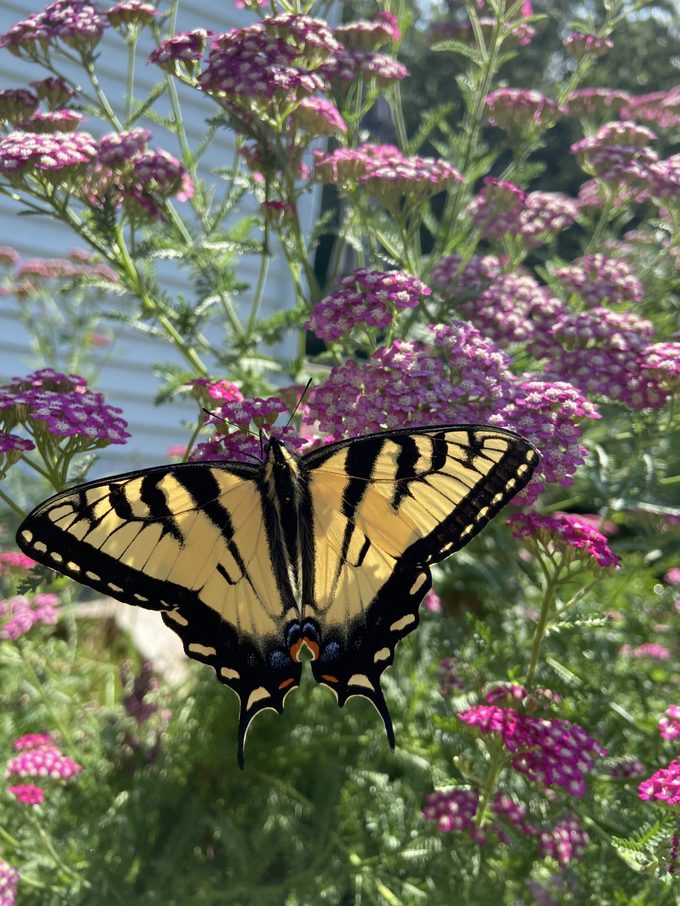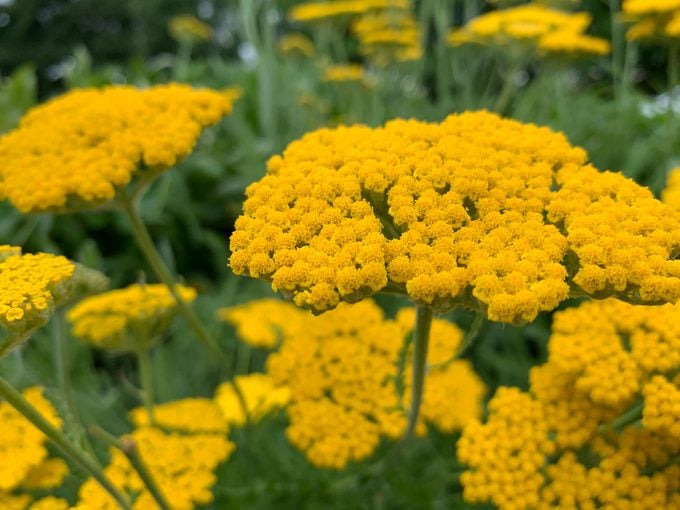Yarrow Plant Care and Growing Tips
Updated: Jun. 11, 2024
Get expert growing advice for a flowering yarrow plant, along with tips for dividing, pruning and cutting back yarrow.
On This Page
How to Grow a Yarrow Plant

A yarrow plant is tough as nails and sneers at neglect—not what you’d expect from such a pretty flower. A thin layer of compost is enough to make yarrow happy.
- Botanical name: Achillea spp.
- Common name: Yarrow
- Zones: 3 to 9
- Light Needs: Full sun
- Soil: Well-draining soil
- Size: Most grow 2 to 4 feet tall
Sun-loving yarrow is very drought tolerant. It just needs water if you receive less than 1 inch of rain a week. Divide the plants every few years to give these perennials some space and reduce the chance of disease. It’s best to do this in early spring before flowering, or in the fall when the plant has finished flowering.
You can grow yarrow from seed. Or get flowers faster by buying plants from the garden center.
When and Where to Plant Yarrow

“Planting in spring or fall is best for to give the plant enough time to set roots and flower or establish rooting before frost. Plant them in a well-draining sunny location,” says Darren Barshaw, product representative for Darwin Perennials.
Yarrow produces easygoing, long-lasting flowers that come into their own once the weather is consistently warm. Suited to most growing conditions, yarrow provides a long season of blooms all the way into fall. To encourage more flowering you can deadhead yarrow once the first flowers fade.
“Yarrow flowers in late-spring to early-summer,” Darren says. “Flowers are flat, pancake-shaped, with many small flower clusters in one mass.”
He says the long-lasting flowers are a good choice for cutting gardens and bouquets, too. You can also grow these perennials in containers.
If you look past the delicate flowers (choose from butter yellow, red, pink, salmon or white), you’ll spot ferny foliage on this resilient plant that’s attractive in its own right.
“Foliage is dark green and feathery looking, soft to the touch. The fern-like foliage is ornamental and attractive even without its colorful flowers. I like how it adds texture to the garden,” Darren says.
Are Yarrow Plants Invasive?
Some species are considered weedy, so do a little research before you buy a yarrow plant—it’s best to stay away from aggressive varieties in small gardens.
Does Yarrow Attract Pollinators?

The pad-like bloom clusters are perfect places for butterflies to land and sip nectar.
“I’ve seen painted lady butterflies on our trial garden plants—beautiful!” Darren says.
Check out the top 10 classic yellow flowers to grow.
Yarrow Plant Problems
According to Darren, “Yarrow is a pretty trouble-free perennial! They’re also deer- and rabbit-resistant, too.”
Pruning and Cutting Back Yarrow Plants

“Most of my yarrow plant stems flopped over. What happened?” asks Birds & Blooms reader Douglas Tracy of Pomfret Center, Connecticut.
Horticultural expert Melinda Myers says, “Yarrow prefers well-draining soil and is drought tolerant once established. It tends to grow tall and flop in moist and rich soil, hot weather or when too much nitrogen fertilizer is applied.
You can adjust your care of yarrow plants to promote more compact growth and prevent the stems from falling over. Just prune the plants back by one third after the first set of flowers fade. Then cut back new growth near the base of the plant after the second flush of flowers finish their show.
Or you can cut the stems halfway to the ground when they are about 18 inches tall and before the first flowers appear. Consider providing some structural support for the yarrow plant by surrounding it with sturdier plants.”
Yarrow Cultivars to Grow

The Milly Rock series (10 to 12 inches tall and wide) is a good choice for the front of the border. Its shorter, compact plant habit won’t swallow-up the other plants nearby.
There are taller options, too, like the New Vintage series (26 to 28 inches tall and 10 to 12 inches wide) for the middle to back of the garden bed. This series doesn’t have gapping between flowers and foliage. And its flowers mature to a softer hue (not brown), keeping it attractive longer.
“The New Vintage series has a very pretty terracotta color that just launched,” Darren says. “And I find the Rose variety to be a stunning wow color.”
Strawberry Seduction is another beauty, with clusters of dusty red flowers with yellow centers that appear throughout the summer. The flowers are small but numerous, rising 18 to 24 inches and fading to hues of light pink and brown. It tends to spread, so divide plants every few years.
Sassy Summer Sunset features fiery-colored flower clusters that are sure to stand out. Moonshine is a classic with lemon yellow blooms and silvery-gray foliage.
About the Experts
Darren Barshaw is a product representative for Darwin Perennials. He earned a degree in ornamental horticulture from Michigan State University.
Melinda Myers is the official gardening expert for Birds & Blooms. She is a TV/radio host, author and columnist who has written more than 20 gardening books. Melinda earned a master’s degree in horticulture from the University of Wisconsin-Madison.




















